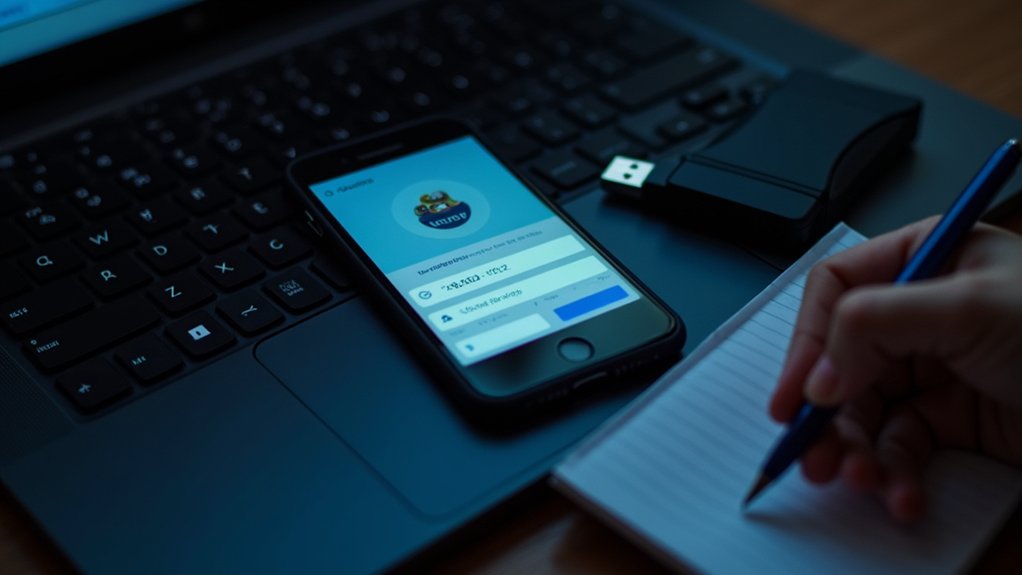
What steps to disable app store password security?
Just how easy is it to disable App Store password security, and what risks should you consider before doing so? Find out what steps come next.


If you use Google Authenticator to protect your apps and online accounts, backing up your Google Authenticator codes is essential. Imagine losing your phone or having it malfunction—without a backup of your Google Authenticator codes, getting back into your favorite apps and productivity tools can be a real headache. By taking a few minutes to backup Google Authenticator codes, you’ll save yourself from the hassle of being locked out and keep your digital life running smoothly. Don’t let a lost device put your app security at risk—make sure to backup your Google Authenticator codes today!

Losing access to your Google Authenticator codes can put your favorite apps and productivity tools at risk.
Many apps depend on Google Authenticator codes for secure login, and without them, you could be locked out of essential accounts. If you don’t have a backup of your Google Authenticator codes, you might lose access to vital mobile apps, miss important updates, or even lose important files and messages forever.
To keep your app ecosystem secure, always make sure your Google Authenticator codes are safely backed up.
Losing your phone or having it stolen can quickly lock you out of your favorite apps, especially if you use Google Authenticator for two-factor authentication.
When Google Authenticator codes are out of reach, it becomes much harder to access essential productivity apps or entertainment apps, leaving your accounts at risk.
That’s why it’s crucial to back up your Google Authenticator codes—this simple step can help you recover your access to important apps and keep your digital life secure, even in emergencies.
Upgrading to a new phone can be exciting, but it also comes with challenges, especially when it comes to app migration.
Transferring Google Authenticator codes from one device to another isn’t always a seamless process. Since Google Authenticator doesn’t automatically sync your codes to the cloud, you can’t just download the app on your new phone and expect everything to appear.
Without careful preparation, you risk losing access to your favorite productivity apps and important accounts.
To make the migration process smoother and stress-free, it’s essential to back up your Google Authenticator codes before switching devices. This simple step ensures you can continue using your must-have apps without interruption and enjoy a hassle-free phone upgrade.
Losing access to your favorite apps can be frustrating, especially if you rely on Google Authenticator for mobile security. If your phone is lost, stolen, or damaged, you might find yourself locked out of your productivity apps and other important accounts.
That’s why it’s crucial to back up your Google Authenticator codes in advance. By keeping a secure backup of your Google Authenticator codes, you ensure uninterrupted access to your mobile tools and entertainment apps, no matter what emergencies arise.
Don’t risk unnecessary lockouts—prepare ahead and keep your Google Authenticator codes safe.
The importance of redundancy in two-factor authentication can’t be overstated, especially when it comes to protecting your favorite apps and mobile tools.
Two-factor authentication adds a crucial layer of security to your accounts, but if you rely on just one device or method, you could lose access if your phone is lost or damaged.
By prioritizing redundancy in your two-factor authentication setup, you ensure you always have a backup way to access your productivity apps, entertainment apps, and other essential mobile tools securely.
Building redundancy into your two-factor authentication process is the smart way to keep your app ecosystem safe and accessible at all times.
Backing up Google Authenticator codes is essential to avoid getting locked out of your favorite apps and productivity tools. One simple method is to screenshot or write down the QR codes or setup keys when you first add an account.
Another effective way to back up Google Authenticator codes is by using a second device to scan the same QR code, giving you access across multiple devices.
Many authenticator apps now also let you export your Google Authenticator codes, making it easier than ever to restore them if you upgrade your phone or switch to a new device.
With these backup strategies, you can keep your apps secure and accessible at all times.
When using apps that rely on Google Authenticator, protecting your recovery codes is essential for keeping your accounts secure.
To ensure the safety of your recovery codes, store them in a secure location, such as a locked safe or a private spot at home, rather than leaving them unprotected. For added security, consider using an encrypted password manager app—this allows you to manage your recovery codes alongside other important credentials.
Avoid saving recovery codes in plain text on your phone, in email, or on cloud services, as this puts your accounts at risk.
When it comes to apps and mobile tools, having a backup is essential for account recovery. If you ever lose your device or delete an important app like Google Authenticator, backups can make account recovery simple and stress-free. By saving your recovery codes, you ensure that account recovery is quick, letting you regain access to your favorite productivity apps and entertainment apps without waiting for tech support. With backups, you stay in control of your app experience, making account recovery easy no matter what happens to your device.
If you use apps that rely on Google Authenticator codes, managing your Google Authenticator codes properly is essential for keeping your accounts secure.
One common mistake is storing Google Authenticator codes in plain text or screenshots, which can put your information at risk. Make sure you never use the same device for both your authentication and backups, as this can compromise your security.
It’s also crucial not to share your Google Authenticator codes with anyone, even those you trust.
Finally, always keep your recovery methods up to date to ensure you can regain access to your favorite apps and productivity tools if needed.
Keeping your Google Authenticator codes secure is essential for anyone who relies on mobile apps to protect their accounts. To maintain top security, make Google Authenticator code management a regular part of your app routine.
Start by reviewing which apps and accounts use Google Authenticator for two-factor authentication, and update your backup methods to ensure you never lose access. Don’t forget to promptly remove Google Authenticator codes for any unused services.
For even stronger protection, always use unique and strong passwords with your favorite productivity apps, entertainment apps, and other mobile tools.
Enable auto-updates on your devices to stay ahead of security threats, watch for any suspicious activity, and revisit your Google Authenticator backup strategy at least twice a year to keep your app ecosystem safe and secure.
Backing up your Google Authenticator codes is crucial for anyone who relies on mobile apps for productivity and security. If you ever lose your phone or switch to a new device without backing up your Google Authenticator codes, you risk being locked out of essential apps and accounts.
By making a habit of backing up your Google Authenticator codes, you ensure seamless access to your favorite productivity apps and entertainment apps, keeping your digital life running smoothly. Don’t let a lost device disrupt your workflow—protect your Google Authenticator codes today for safer, uninterrupted app experiences.

Just how easy is it to disable App Store password security, and what risks should you consider before doing so? Find out what steps come next.

Surprised by how hackers can bypass two-factor codes from authenticator apps? See what risks you might not have considered yet.

Beware: even trusted two-factor apps aren’t immune to malware—discover the hidden threats that could compromise your security before it’s too late.

Make your Instagram account nearly unbreakable—discover the effortless way to set up two-factor authentication with an app, but don’t miss this crucial step.

Searching for the best free antivirus for iPhone? See which app stands out in 2024 and discover the secret to truly protecting your device.

Searching for top free Android antivirus apps? See which features matter most and discover the secret to choosing the safest option for your device.